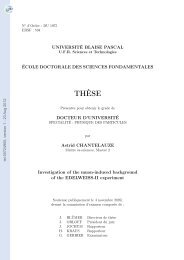rapport de stage janus : radiographie par les rayons ... - HAL - IN2P3
rapport de stage janus : radiographie par les rayons ... - HAL - IN2P3
rapport de stage janus : radiographie par les rayons ... - HAL - IN2P3
Create successful ePaper yourself
Turn your PDF publications into a flip-book with our unique Google optimized e-Paper software.
β est la vitesse <strong>de</strong> la <strong>par</strong>ticule inci<strong>de</strong>nte divisée <strong>par</strong> la célérité <strong>de</strong> la<br />
lumière.<br />
z est la charge <strong>de</strong> la <strong>par</strong>ticule en unité <strong>de</strong> e.<br />
Et : Q Z ( Z 1)<br />
= + pour <strong>les</strong> électrons et <strong>les</strong> positrons.<br />
Q = Z<br />
Avec Z le numéro atomique du matériau traversé.<br />
B est défini <strong>par</strong> l’équation :<br />
g ( B) = ln B − B + ln γ − 0.154 = 0<br />
2<br />
3 qz ρδ x<br />
Où : γ = 8.831× 10 2<br />
β AΔ<br />
et<br />
⎛ Zz ⎞<br />
Δ = 1.13 + 3.76⎜ ⎟<br />
⎝137β ⎠<br />
Avec A le nombre <strong>de</strong> masse du matériau traversé.<br />
1/3<br />
Et q ( Z 1)<br />
Z<br />
= + pour <strong>les</strong> électrons et <strong>les</strong> positrons.<br />
q= 4/3<br />
Z pour <strong>les</strong> autres <strong>par</strong>ticu<strong>les</strong>.<br />
Pour un γ donné on peut trouver B <strong>de</strong> façon numérique en utilisant la<br />
métho<strong>de</strong> <strong>de</strong> Newton pour trouver <strong>les</strong> racines <strong>de</strong> g (B).<br />
Les fonctions Fk(η) sont définies <strong>par</strong> l’intégrale :<br />
k<br />
2 2 2<br />
1<br />
⎛ − y ⎞ ⎡ y ⎛ y ⎞⎤<br />
= 0 exp ⎢ ln ⎥<br />
( η ) ( η )<br />
∫<br />
Fk J y ⎜ ⎟ ⎜ ⎟ ydy<br />
k!<br />
⎝ 4 ⎠ ⎣ 4 ⎝ 4 ⎠⎦<br />
Où J0 est la fonction <strong>de</strong> Bessel. Il existe <strong>de</strong>s tabulation <strong>de</strong>s Fk(η).<br />
En général on ne calcul pas plus que <strong>les</strong> trois premiers termes <strong>de</strong> la<br />
distribution <strong>de</strong> Molière.<br />
Pour <strong>les</strong> ang<strong>les</strong> petits cette distribution est proche d’une distribution<br />
gaussienne mais il intervient un terme correctif quand <strong>les</strong> ang<strong>les</strong> augmentent.<br />
21<br />
2




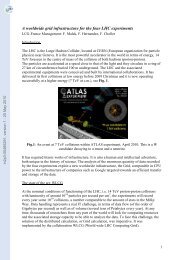



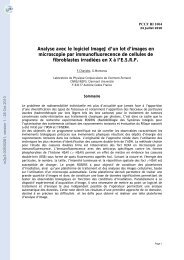
![[in2p3-00383985, v1] NUCLEAR PHYSICS at GANIL ... - HAL - IN2P3](https://img.yumpu.com/19016755/1/185x260/in2p3-00383985-v1-nuclear-physics-at-ganil-hal-in2p3.jpg?quality=85)
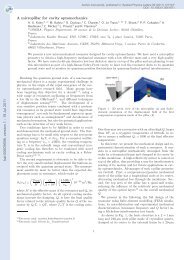
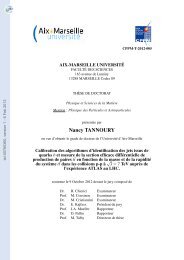
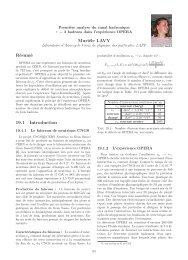
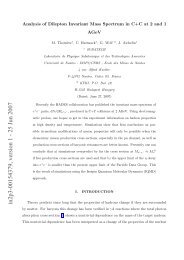

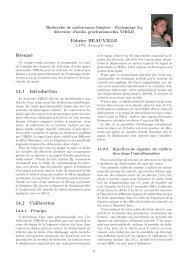
![[tel-00752304, v1] Pions réels et virtuels dans les noyaux](https://img.yumpu.com/19016523/1/184x260/tel-00752304-v1-pions-reels-et-virtuels-dans-les-noyaux.jpg?quality=85)
